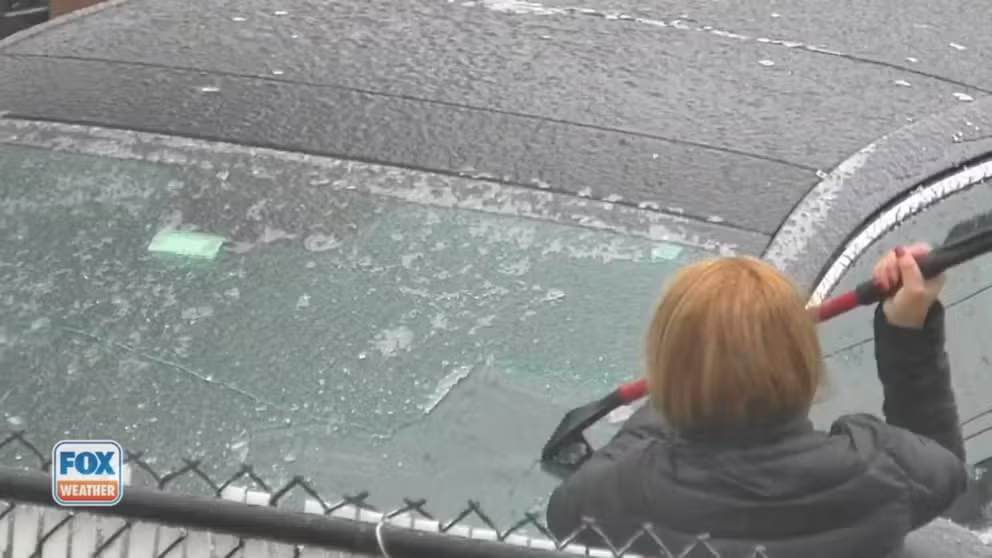What is freezing rain?
Snow gets a lot of the attention during winter storms, but an ice storm of freezing rain can actually have greater impacts on a region.
What is freezing rain?
Snow gets a lot of attention during winter storms, but an ice storm of freezing rain can have a more significant impact on a region.
Snow gets a lot of attention during winter storms, but an ice storm of freezing rain can be devastating to a region.
Here are seven things to know about freezing rain:
1) It's rain that has been "supercooled"
Freezing rain begins its journey as a snowflake that then melts into a raindrop as it encounters a slice of above-freezing air on its free-fall through the atmosphere. If the air stays above freezing, it'll remain as rain.
If the raindrop encounters a renewed layer of below-freezing air, the drop will begin the process of refreezing. First, it'll become "supercooled", as in reaching temperatures at or below freezing. And then, if there is enough time to finish freezing before it comes to the ground, eventually, the drop turns into an ice pellet. That's known as sleet.
But if the layer of sub-freezing air is shallow, the drop only has enough time to reach the liquid "supercooled" state.
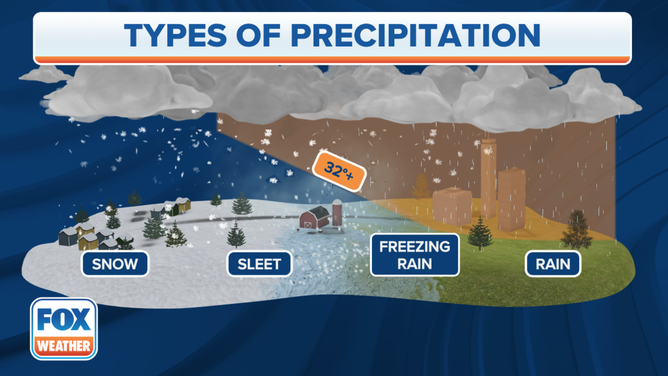
Snow gets a lot of attention during winter storms, but an ice storm of freezing rain can have a more significant impact on a region.
(FOX Weather)
SNOW, SLEET, FREEZING RAIN AND HAIL: WHAT'S THE DIFFERENCE?
And when a supercooled drop hits the ground, it instantly freezes to any surface it touches -- thus the term, "freezing rain."
As more freezing rain falls, a glaze of ice will form on everything -- sidewalks, roads, cars, trees, power lines, homes -- that will only get thicker as the storm continues.
2) Freezing rain has caused some of the nation's worst crashes
Even a thin glaze of freezing rain can erase all traction on pavement, leading to dozens to hundreds of crashes as cars and trucks careen out of control.
"Freezing rain is the worst," the National Weather Service says. "(It's) more dangerous than snow, as ice can form on pavement."
In 2021, six people were killed in Fort Worth when an ice storm led to a 135-vehicle pileup on Interstate 35W.
HOW TO DRIVE ON THE ICE AND IN THE SNOW
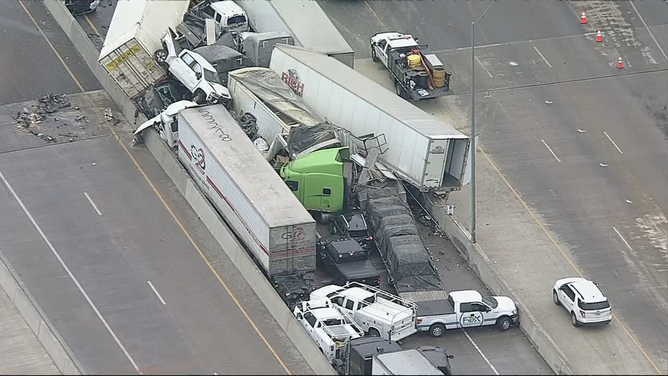
Aerial footage of a deadly crash on Fort Worth, Texas' I-35W on Feb. 11, 2021.
(FOX 4 Dallas)
According to the Federal Highway Administration, Over 1,300 people are killed on snowy or icy pavement each year.
3) It only takes 1/2" of ice to cause crippling effects
It might not seem like much, but even just a quarter inch of ice can be disruptive to a region with numerous power outages and some tree damage, along with slick roads.
And once ice thickness reaches just a half inch, it will have crippling effects on an area. Widespread power outages and tree falls will occur as branches and power lines succumb to the weight of all that ice.
HOW MUCH ICE IS NEEDED TO KNOCK OUT POWER, DAMAGE TREES?
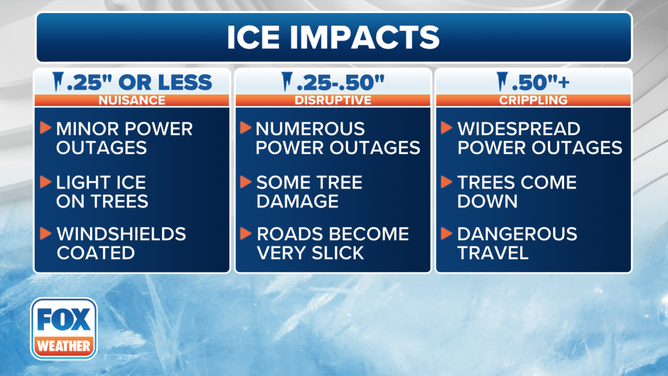
(FOX Weather)
4) Power outages have lasted days to weeks in the greatest storms
Unlike a windstorm where some trees and power lines might topple, but other parts of the power grid may avoid damage, a major ice storm can wipe out a majority of power lines across the region.
An ice storm in Dec. 2007 that struck across the Midwest left wide swaths of Kansas under 1-2 inches of ice, with some spots seeing 2-4 inches of ice accretion, according to the National Weather Service in Wichita.
REMOVING ICE FROM YOUR WINDSHIELD CAN BE EASY – IF YOU DO IT THE RIGHT WAY

Succumbing to the ice and rain, a tree fell on top of a house on Tuesday, December 11, 2007, in southern Overland Park, Kansas.
(Shane Keyser/Kansas City Star/Tribune News Service / Getty Images)
"Many areas were without power for 1-2 weeks!" the National Weather Service wrote. "Damage to the electrical infrastructure alone was estimated at $136.2 million making this the costliest ice storm in Kansas history."
5) Seeing pink? Watch out for the skating rink
On weather forecast maps and on most Doppler Radar screens, freezing rain or sleet is denoted as a pink or purple layer, frequently sandwiched between an area of snow in blue and rain in green.
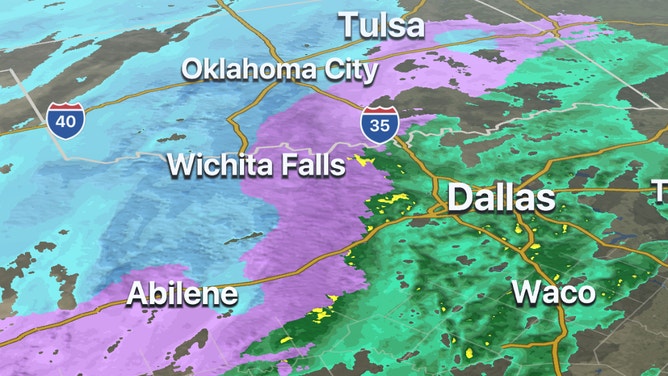
FOX Weather App 3-D Radar shows a mix of snow (blue), rain (green) and mixed precipitation (pink).
(FOX Weather)
6) Look for freezing rain where warm and cold air masses collide
Freezing rain and sleet are most commonly found around the boundary between the warmer air ahead of the approaching winter storm and the colder air behind it. It's especially common on the northern side of warm fronts.
That's where you can get the warm air nudged in between the snowy cloud base and cold air trapped on the ground.
7) Ice "accretes", it doesn't accumulate
You might hear meteorologists or emergency managers refer to ice "accretions" when describing amounts of freezing rain.
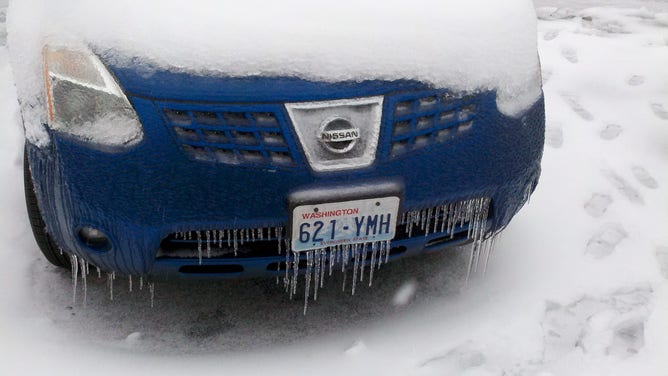
Thick ice covers a car in Burien, Wash. during an ice storm in Jan. 2012.
(Scott Sistek / FOX Weather)
While snow and rain totals are communicated as accumulations, ice accretes as ice grows in layers as more freezing rain falls, as opposed to collecting on a surface or in a container like snow and ice.
